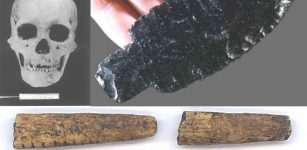Brilliant Prehistoric Cave Paintings Of Lascaux – Who Were Their Unknown Creators?
MessageToEagle.com – The identity of the masters of Lascaux, who possessed impressive knowledge of artistic technique and equally sophisticated knowledge remains shrouded in mystery.
What source of light did they use? How did they protect their great work at Lascaux from atmospheric damage?
As the Italian journalist Loris Mannucci once wrote: “these works of art are 25,000 years old, yet they show such perfection in their design, color-scheme (especially red, yellow and black) and sense of movement as to upset many of our ideas concerning prehistoric man.
The paintings were made at different times, and it is a problem how these artists managed to construct a scaffolding so as to paint the roofs of caves that were several yards in height.”
In the Lascaux Caverns, world-renowned for their Magdalenian paintings, one can still see the holes in the rock that supported wooden crossbeams. Probably looking similar to what Michelangelo utilized many millennia later, these crossbeams held scaffolding that enabled the Cro-Magnon artists to execute their works on the cave ceilings, ten to twelve feet above the cavern floor.
We do not know whether the Lascaux caves were a sanctuary or a dwelling place, but we can say with certainty that the place was frequently used by many people and the pictures at Lascaux managed to survive millennia.
Curiously, the last two to three decades of frequent tourist visitations at Lascaux have seriously damaged the beautiful wall paintings and the cave’s rocky interior has begun to disintegrate in many places.
Very long time ago, in prehistory, the Lascaux Cave, a deep and dark place could be the humans’ first center of observation of the sky.
A painted map of the prehistoric cosmos covers one of the walls of the Lascaux Cave in the vicinity of the Shaft of the Dead Man.
The Lascaux Cave, located on a hill at Dordogne, near Montignac, in southern France, is one and most known of over 350 ancient decorated sites.
It was discovered accidentally in September 1940 by a group of teenagers. It is a classified historic building which as one of the first sites profited from a new method of dating: Carbon-14. There are more than 100 Paleolithic caves in the region.
According to German researcher Michael Rappenglueck, of the University of Munich, a map depicting the eyes of the bull, birdman and bird represents the three prominent stars Vega, Deneb and Altair.
All three represents the so called “Summer Triangle” composed of the brightest celestial objects in the sky during the middle of a northern summer.
Among other frescoes, located near the entrance of the cave, there is an impressive painting of a bull. Hanging over its shoulder is a depiction of a map of the Pleiades, the cluster of stars sometimes called the Seven Sisters.
Inside the bull painting, there are also indications of spots that may be a representation of other stars found in that region of sky. Today, this region forms part of the constellation of Taurus the bull. The ancients, who lived thousands of years ago, were much more sophisticated than many of us believe.
Was the Lascaux cave some kind of ancient planetarium where stars were charted?
In recent years, new research has suggested that the Lascaux paintings may incorporate prehistoric star charts. Dr Michael Rappenglueck of the University of Munich argued that some of the non-figurative dot clusters and dots within some of the figurative images correlate with the constellations of Taurus, The Pleiades and the grouping known as the “Summer Triangle”.
This impressive legacy left to us by the ancients, consists of more than 1,800 figures of animals like horses, bison, wolves, mammoths, ibex, aurochs, deer, lions and bears and many other abstract designs.
The original cave, a very fragile ancient place of 250 m long, was closed to the public in 1963 when a deteriorating fungus “attacked” its walls. Since 1983 people can visit the Lascaux Cave’s “reproduction”.
The first hall of the system is the Great Hall of the Bulls. This large fresco, covering about 20 meters depicts: horses, bulls and stags. After the Great Hall, there is about thirty meters long surface called the Painted Gallery with the walls entirely covered with various figures.
To the right of the Great Hall of the Bulls, there is the Lateral Passage, a low corridor, where only a few paintings and engravings survived.
This corridor connects the Chamber of Engravings, a large round area, with more than 600 hundred engraved figures, with the Main Gallery and the Chamber of Felines. The Shaft of the Dead Man, where no traces of any human were ever found, is set a little apart, at the far end of the Chamber of Engravings, and the Silted-up Chambers are in the same direction.
Brilliant prehistoric paintings of Lascaux, with their anatomically perfect details of all depicted animals, are rendered with great art skills like hadowing, highlighting, stenciling and the use of perspective, a technique that was not rediscovered until the Golden Age in Greece.
However, looking at the millennia old Paleolithic artwork of Lascaux, where only simple stick figures represent a man, we cannot tell if the artists were Neanderthal man or Cro-Magnon man or perhaps someone else.
Copyright © MessageToEagle.com. All rights reserved. This material may not be published, broadcast, rewritten or redistributed in whole or part without the express written permission of MessageToEagle.com

















